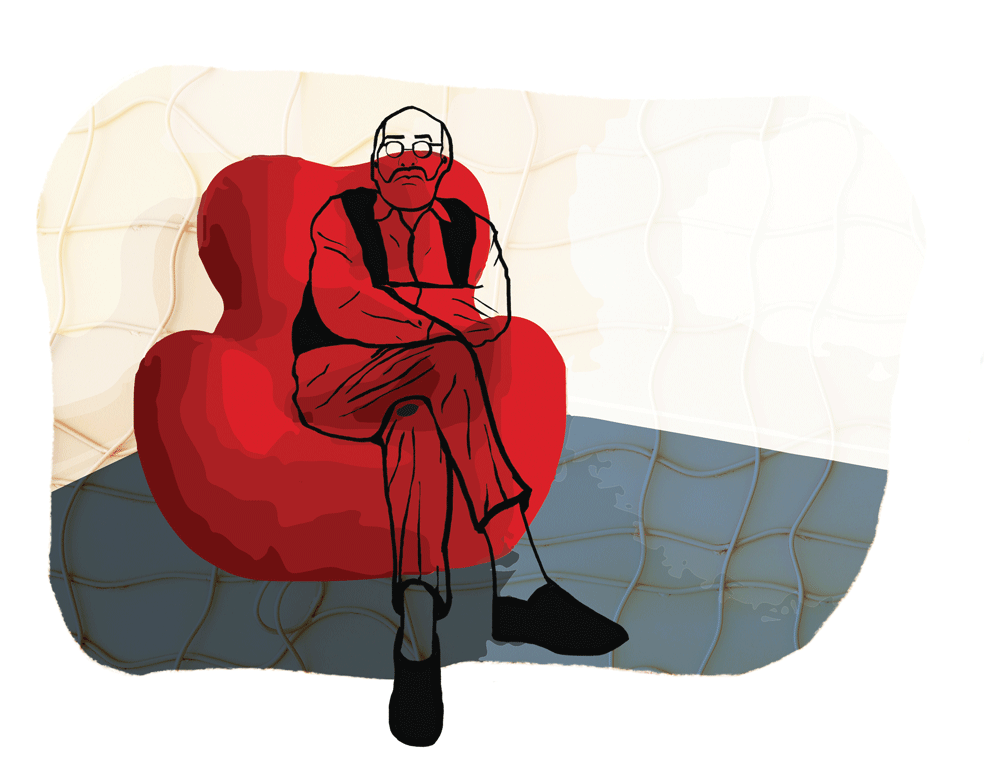
Recent news from the design community declared internationally acclaimed designer Gaetano Pesce dead — but the reports of his death seem to have been exaggerated, seeing as he spoke at the Art Institute of Chicago on October 27. Known for pulling similar stunts of eccentricity over his 50-year-long career, Pesce is infamous for fighting conformity.
As I sat in the audience in the Rubloff Auditorium awaiting the architecture lecture, I was surprised as anyone else when Pesce came out on stage and announced that he would neither sit in the provided chair, nor talk primarily about architecture. He stood, and instead spoke about his unique design philosophy developed over his half-century-long career. It seems to be working for him. Pesce has won awards across many fields, such as the Interior Design Magazine Award for Furniture, the Good Design Award for Architecture, and the Lawrence J. Israel Prize from the Fashion Institute of Technology in New York.
During his lecture, Pesce described “interdisciplinarity” as a natural state for human beings. “You are only an architect when you do architecture,” Pesce said. “Sometimes, you eat pasta.”
Pesce’s roots as an Italian designer come up frequently in his work. A recent project started by the Italian government detailed a bridge spanning the Straits of Messina, modeled after the Golden Gate Bridge in San Francisco. Although respectful of the design, Pesce criticized the Italian government’s appropriation of the uniquely American model, stating that bridges in Italy should both look and act differently than they do in other countries. Pesce, instead, created plans for an inhabitable S-shaped bridge. In keeping with the stylish and relaxed nature of Italian culture, the bridge would support restaurants and hotels, all of which would overlook mainland Italian or Sicilian coastlines, depending on the location. Suddenly, being stuck in traffic on a bridge seems much more appealing.
“Why spend five thousand million euros to make something you would drive across in three minutes?” Pesce questioned. “We need something exciting in the city, because life is exciting.”
Pesce’s philosophy of design changes from city to city, place to place. For example, Pesce criticized The Shard — a glass covered pyramid-skyscraper newly erected in London — as poor design, due to its ill-fitted placement in the historically rich city; instead, Pesce suggested it might fit better in North Korea.
How so? Comparing The Shard to the unfinished Ryugyong Hotel commissioned by the North Korean government, he said that a key difference between the two buildings was that despite them both being poorly designed, the Ryugyong Hotel’s monolithic and featureless nature sadly but faultlessly fits North Korea’s status as, as he put it, a “shit country”: to Pesce, a pyramid is a building that belongs to a dictatorship, symbolic of a “one above all” society. A controversial remark, but not out of the ordinary for Pesce.
“Abstraction is super boring,” he said, adding, “Art was always practical.”
Yet, the 77-year-old Italian has created furniture shaped like breasts, designed a lavender-scented house, and a nine-story building fitted with both living walls and a vertical garden. By what definition is that not abstraction? In Pesce’s mind, abstraction is the creation of something with intentionally less foundation in reality, something that lacks origin. Instead, Pesce strives to “grow” his work out of the environment it is created in.
“Art is able to criticize reality,” said Pesce. In some cases, his work does more than criticize reality: It changes it. In response to the simultaneous need for green areas but lack of space in urban planning, Pesce’s “Organic Building” in Osaka, Japan, has a water distribution system for more than 80 types of indigenous plants, which grow on the walls of the structure. The building is vibrant, standing tall and colorful amongst a series of dull, nondescript residential blocks.
Pesce proudly asserted this as one of his greatest achievements, and that the Japanese regional government recognized his building as a “public utility,” and funded both the hydration system and part of the building’s construction. It is a marvel of both functionality and aesthetic.
For Pesce, no opportunity to relay meaning from function is missed. His 1969 furniture set — in which a user sits atop two feminine legs, connected to an ottoman modeled after a ball and chain — serves as an insight into his worldview. Deriding the overrepresentation of masculinity in design, Pesce depicts a future of design that is more flexible and fluid, or in his words, delicate.
During the lecture, Pesce criticized popular structures such as New York’s 432 Park Avenue (the tallest residential tower in the Western Hemisphere) as being stiff and unimaginative. “The future is feminine,” he said.
In a world where there is less space, more value will be placed on creativity and diversity rather than size. As such, it is wasteful and “typical” of masculine design culture to pride oneself on building the tallest or largest skyscraper.
Size is not what makes design impressive or strong — as Pesce put it, “You are strong because you have ideas.”







